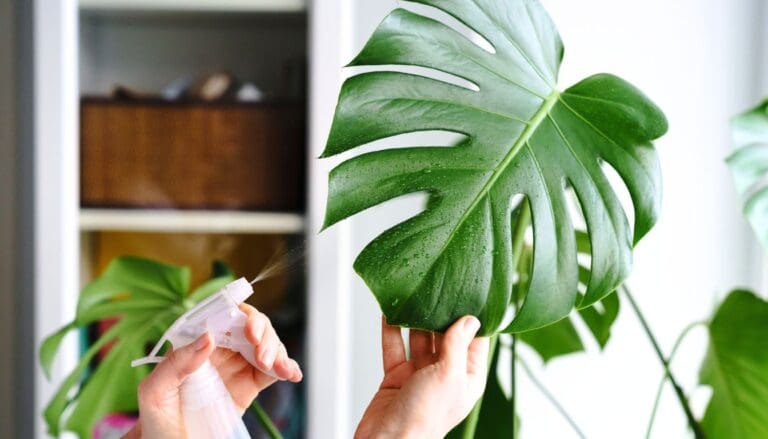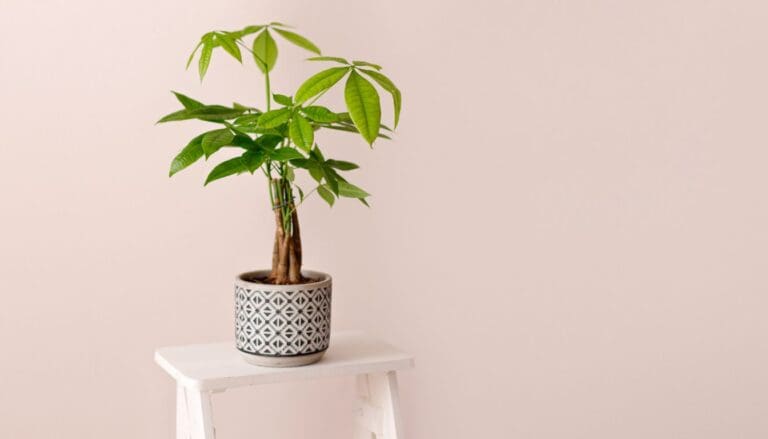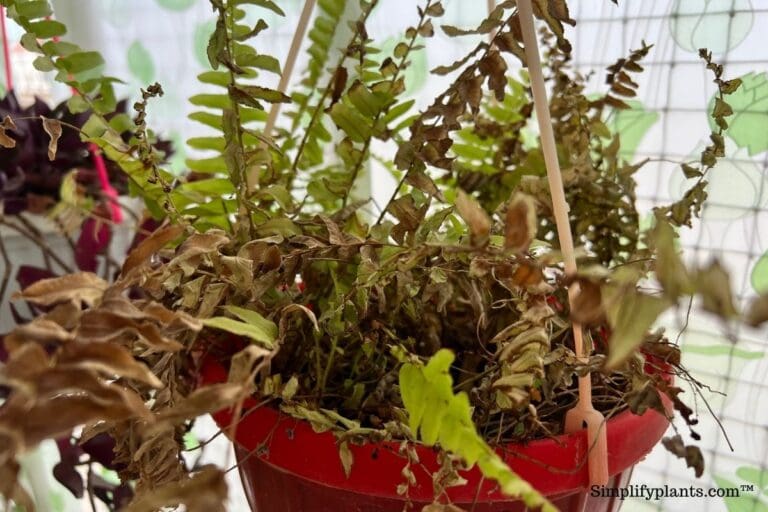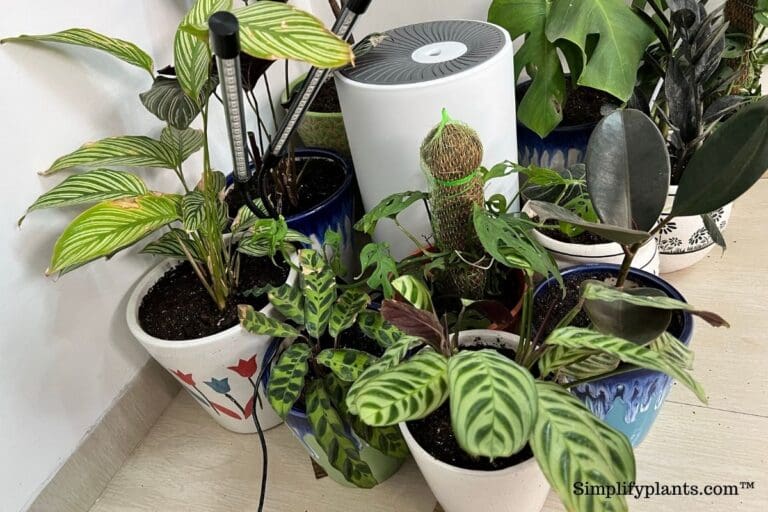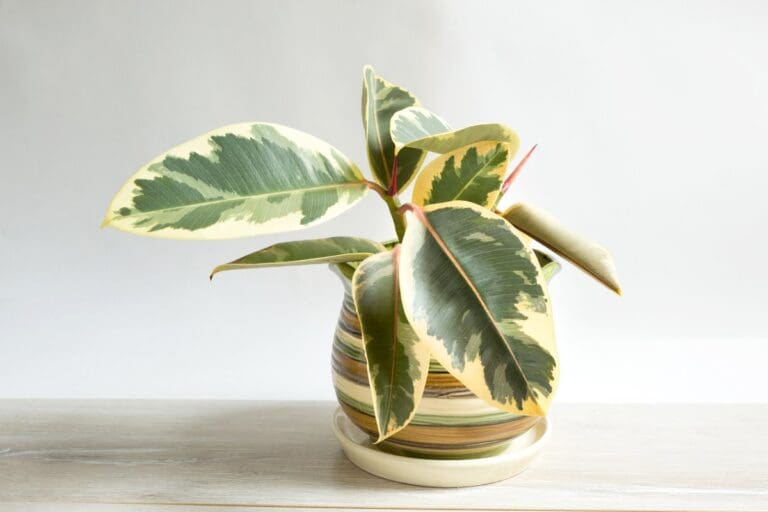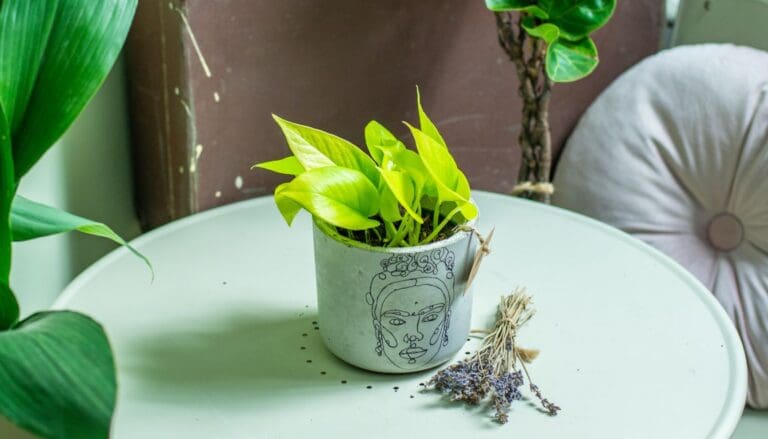Pothos Leaves Turning Brown? 9 Reasons Why & Easy Fix
Have you noticed that the leaves of your pothos plant are turning brown, and you’re not sure why? In this blog, we will explore 9 reasons why pothos leaves turn brown and share some easy fixes.
Pothos turn brown from incorrect watering and light, low humidity, poor soil, over-fertilization, rootbound, cold stress, and infestations. Fix brown Pothos with better watering and light, drainage, correct fertilization, repotting, avoiding drafts, and quick action for infestations.
Since several reasons cause browning, you must discover the actual cause and troubleshoot them soon. In this article, we will analyze all these reasons in detail and take easy steps to fix them.
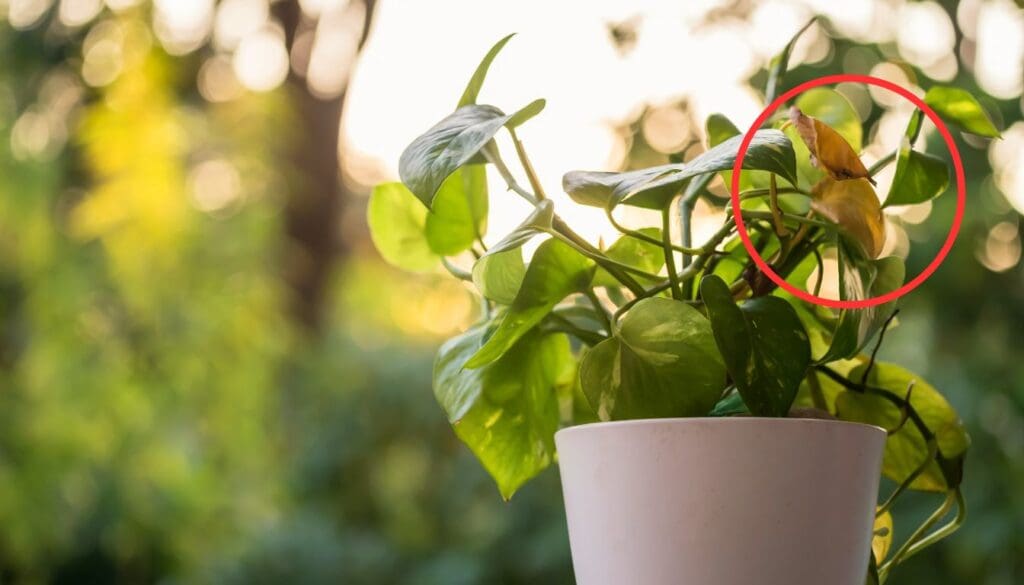
Please note: Simplify Plants is reader-supported. As an Amazon Associate, I earn from qualifying purchases made by our readers with no extra cost added to you all! Some links in the post are affiliate links and I get a commission from purchases made through links in the post.
1. Improper Watering Causes Pothos Leaves to Turn Brown
One of the most common reasons behind brown leaves in the Pothos plant is improper watering.
Pothos thrive best under dry and warm environments, but they also love some moisture.
Overwatering, underwatering, and irregular watering can turn the leaves brown.
Let’s go through them one by one.
Overwatering Pothos plants
Excessive moisture suffocates the roots, cuts off oxygen, and blocks the transfer of moisture and nutrients, leading to brown leaves in the pothos plant.
Over time, if the soil remains soggy, it creates a favorable environment for fungi.
These fungi decay the roots, eventually leading to root rot.
You will find soft brown spots with yellow outlines on the leaves that enlarge and turn the leaves brown.
Pothos must be watered to stay consistently moist, but the soil must also dry before watering.
Therefore, you can’t go overboard while watering.
Overwatering is easy, especially for beginners.
If you have overwatered the pothos plant, here’s what you need to do:
- Stop watering and let the soil dry out.
- In the next watering session, be gentle and ensure the top few inches of the soil have dried.
- Before watering, you can use your finger or a moisture meter to determine the soil moisture.
- If there’s a root rot, you might have to repot your pothos plant with new soil mix in a new pot.
Underwatering Pothos plants
Hydration is essential, and keeping the pothos plant underwatered for too long can deteriorate the plant’s health.
When roots get dehydrated, the pothos plant can’t absorb the moisture and nutrients, resulting in wilting, dry leaves, and yellow or brown leaves.
However, solving this is easier than overwatering.
Check the soil. If it feels dry, water the pothos plant deeply until the excess drains out.
Consider bottom watering if needed because dry and hard soil sometimes repel water during top watering.
If underwatering is the issue, your pothos plant will perk up, and new leaves will grow.
Watering Pothos inconsistently
Letting the soil dry before watering is necessary, but consistency is the key. It can reduce the chances of browning in pothos.
Some gardeners allow the soil to dry out too much and then water it deeply.
Deep and infrequent watering is helpful, but the bottom few inches of the soil at the root section should be slightly moist.
Dehydrating the roots and then watering is not the rule.
You can also maintain a proper routine based on your pothos plant’s behavior and your personal experience.
I used to struggle a lot as a beginner.
Initially, I used to check the soil before watering.
After years of experience, I maintain a routine.
I water my Pothos every 5-7 days in the spring and summer and every 2-3 weeks in winter.
Even though I follow this routine, I check the soil moisture before watering.

2. Impact of Soil Quality on Pothos Leaf Browning
All potting soil types are not ideal for Pothos.
For Pothos, you need well-drained, nutrient-rich, high-quality soil.
If brown leaves are from improper watering, soil is the main issue because:
- Poorly drained soil causes overwatering
- Soil with poor retention qualities will lead to underwatering.
You can add materials to improve drainage or retention or replace the soil and repot the pothos plant.
Add perlite or coarse sand to improve drainage and peat to improve retention qualities.
Additionally, you can use pebbles, plastic recycling, and broken pieces of a pot.
It will let the water slide out easily through the drainage holes.
Continue caring for the pothos plant. The discolored leaves will fall off on their own, and your plant will have new growth within a few weeks.
3. Pothos Leaf Turning Brown Due To Inadequate Light
Pothos need bright indirect sunlight for around 10-12 hours.
It can also tolerate low light conditions but not zero light or darkness.
The pothos plant needs sunlight for chlorophyll production.
With insufficient light, the leaves cannot have good color.
They become pale and yellow, later turning to brown.
Ideally, Pothos needs around 150-500 foot candles of light.
If your leaves are becoming brown, check the light conditions once.
If light is the issue, it is time to shift your pothos plant to a bright location with dappled sunlight.
Use fluorescent or LED lights if needed.
Direct sun exposure is also unhealthy. Browning at the leaves’ tips, edges, and surface indicates sunburns from direct sunlight.
If the pothos plant is exposed to direct sunlight, move it a few feet away from the window.
Put up sheer curtains or Venetian blinds to filter the plant.
An east-facing window provides the best-dappled sunlight throughout the day.
Shift your pothos plant to such a location if you have it.
Also read: Pothos light requirement guide.
4. Addressing Pothos Leaf Turning Brown Due to Low Humidity
Belonging to the tropical regions, Pothos love high humidity, around 70-80%.
Indoors, if such high humidity feels uncomfortable, at least 40-60% of humidity should be maintained.
Humidity below 40-50% will lead to faster moisture loss, dry leaves, and browning from the tips and edges to the entire leaf.
A few months back, I received a question from my reader where she couldn’t understand the reason behind the brown leaves in her Pothos.
While questioning about the care she provides, I told her to check the humidity.
But she didn’t have a hygrometer.
Since I also wasn’t entirely sure, but it was a hunch, I told her to increase the humidity by misting and told her to inform me after 1-2 weeks.
She did everything correctly, but we weren’t sure about the humidity.
After 1-2 weeks, she said that her problem was solved.
Understanding whether humidity is the issue is confusing, but solving it is easy.
If you have solved the above issues and still get browning, consider checking the moisture level with a hygrometer.
Another way to check the room’s humidity is by putting some ice cubes in the room and checking it after a few minutes.
If condensation has formed outside the glass, humidity is high.
Otherwise, it’s low.
If the humidity is low, increase it by installing humidifiers, regular misting, putting pebble trays under the pot, and grouping multiple plants.
Also read: Do pothos like misting?
5. Pothos Leaves are turning brown due to fertilizer burns

When you over-fertilize the Pothos plants, the excess salt from the fertilizers accumulates in the soil and burns the roots.
The leaves will first turn brown at the tips and edges and slowly spread to the entire leaf. It is another form of scorching from fertilizers.
There are two things you can do:
- Take the pot outside and water the soil deeply unless the excess drains out. Let it dry, and do it again 2-3 times unless all the salts drain.
- Replace the entire soil with a new soil mix. Do this if you have substantially over-fertilized your Pothos.
Don’t fertilize for a few weeks until you see signs of recovery.
Fertilize your pothos plant with a balanced (10-10-10 or 20-20-20 NPK) liquid fertilizer every 4-6 weeks and 1-2 times a year with a slow release.
Fertilize your pothos plant only during the spring and summer. Stop it during the fall and winter as the plant stays dormant.
6. Pothos leaves are turning brown due to rootbound
Generally, Pothos grow very fast outdoors. Indoors, their growth rate is slower than the wild, but still they are listed as fast growers.
Hence, you must repot the pothos plant once every 1-2 years to give the roots room to grow and spread.
When you don’t repot the plant for too long, roots grow circularly and become compact leading to a root-bound pothos plant.
In such conditions, the roots cannot transfer the nutrients and moisture to the other plant parts, leading to yellow or brown leaves.
Root rot is also possible because roots can’t breathe with such compactness.
To fix the issue, repot the Pothos to a larger pot 1-2 inches larger than the old one.
Check for obvious rootbound signs like roots coming out of drainage holes or soil surface or the pot has more roots than soil.
While repotting, remove some long, thin, damaged, and incredibly intertwined plant roots. Trim only 10% of the roots.
Use well-drained soil, fill the new pot, and plant the Pothos.
Water the pothos plant and keep it near a bright location receiving dappled sunlight.
Don’t feed now. Since the soil is new, it will provide some nutrients for a few weeks.
Start feeding when your plant has new growth.
7. Pothos Leaf Browning Caused by Pests and Diseases
Pests and diseases are the last cause of brown leaves in Pothos.
With a small amount of infestation, you won’t see anything serious.
However, you should take steps immediately, otherwise, they spread quickly and kill the entire pothos plant.
Pothos pests causing it to turn brown
Aphids and mealybugs suck the plant sap and dehydrate the plant.
The cells of the plant don’t have enough nutrients left.
The leaves become deformed and turn brown.
Spider mites are tiny pests spotted by thin webbings on the leaves.
They also suck the pothos plant sap and turn the leaves brown.
Whiteflies are another type of bugs that also suck the plant sap.
Most of these pests live under the leaves.
That’s why it is difficult to spot unless the infestation increases or you check the plant thoroughly.
Here’s what you need to do to eliminate them:
- Isolate your pothos plant and shower it to dislodge the insects.
- Spray neem oil on the infected areas.
- Take a cotton ball dipped in rubbing alcohol and wipe the suspected areas.
- Release natural predators like ladybugs.
- Spray acaricide to get rid of mites.
- Use insecticidal soaps or chemical pesticides if the infestation is large.
Pothos diseases causing it to turn brown
Several diseases can attack your Pothos plant and turn the leaves brown.
But to understand what disease your plant is having, check for the specific signs of the disease besides browning.
For example, if you have bacterial wilt, the leaves will suddenly become wilted and brown with black veins along the stems.
Fungal infections like southern blight cause brown leaves with white strands of fungus growing from the soil and progressing to the plant stem.
Pests carry some infections.
You will see the disease right after a pest infestation.
Once you notice these signs, you need to act quickly.
- Remove the infected pothos plant parts, and quarantine your plant.
- Spray some systemic or copper-based fungicide on the infected areas.
- You can also use homemade fungicide by mixing 1 part baking soda with 10 parts water and ½ teaspoon of insecticidal soap. The insecticidal soap will control the disease and the pest causing the disease.
- If these solutions prove ineffective, discard the entire pothos plant.
Root rot is another disease caused by exposure to prolonged soggy soil. Extended moisture attracts a fungus that begins to decay the roots.
You will notice the leaves turning brown, the mushy stems, and a foul smell coming from the soil.
- Take out the pothos plant, remove the maximum soil, and examine the roots.
- The brown and mushy roots are rotten and need to be removed.
- If maximum roots need removal, gather some healthy cuttings and propagate them.
- You can save the pothos plant if the damage is below 40-50%.
- Spray some fungicide on the roots and repot it to a new pot with a new soil mix.
- Ensure good drainage.
- Water the pothos plant and keep it in a well-lit area.
- Don’t feed unless you see new growth.

8. Pothos are turning brown due to environmental factors
Pothos plants are ideal for beginners as they can tolerate several living conditions and environmental factors.
While it’s true, Pothos performs best when the temperature stays between 70-90°F.
The ideal temperature range is 60-90°F. Anything below or above this range will hurt the plants.
Excessive high or low temperatures can shock the pothos plant and result in browning.
If the room temperature drops below 60°F, the pothos plant will stop growing.
Cold drafts can damage cells and cause the leaves to turn brown.
When the temperature rises above 90°F, the plant suffers from heat stress and turns the leaves brown.
High temperature dries the soil faster, resulting in constant dehydration and brown leaves.
If you don’t act now, your pothos plant may die.
To fix the issue:
- Shift your pothos plant to a room with a consistent temperature of 70-90°F.
- Avoid areas with cold or hot drafts, for example, open windows, doors, and balconies.
- Avoid placing the Pothos close to any heating or cooling systems. If you keep them in a room with these systems, maintain a 10-12 feet distance between them.
9. Pothos Leaves are turning brown due to aging
Finally, your Pothos will not live forever, nor will the leaves.
As the leaves grow old, they can’t absorb moisture and nutrients.
They become useless and slowly turn brown and fall off.
There is no solution to this problem.
Don’t worry; new leaves will grow if the pothos plant stays safe and healthy.
I had this issue as a beginner, learning the essential care tips.
After several experiments, I couldn’t determine the reason for the browning.
One day, when one of my houseplant-lover friends visited my house, I showed her the condition, and she told me that it was mere aging because the plant was healthy.
So, if you are doing everything correctly and your pothos plant is flourishing, browning means old age.
Preventive measures to keep the Pothos from browning
- Check the light levels of the Pothos plants. Make sure they receive bright, dappled sunlight for 10-12 hours.
- Water smartly. Pothos will love drying out before watering. Let 40-50% of the soil dry out before watering.
- Prioritize drainage. Use well-drained, fertile soil with 6.1-6.8 pH levels for the Pothos plants. Also, use a pot with drainage holes.
- Maintain warm temperatures ranging around 70-90°F and 60-70% humidity.
- Fertilize the pothos plant only during the spring and summer every 4-6 weeks with a liquid fertilizer and 1-2 times per year with a slow-release fertilizer.
- Keep your pothos plant clean. It allows you to check out for pests and diseases. You can take immediate action and prevent the plant from suffering too much.
- Pothos can overgrow quickly. Therefore, prune them regularly during the active months when they overgrow. It will improve air circulation and prevent several diseases.
- Repot the pothos plant once every 1-2 years.
- Love your pothos plant. Pothos is quite a low-maintenance plant, but giving extra care will help them thrive and avoid several issues, including browning.
Final thoughts
Common reasons that turn your Pothos brown are incorrect watering habits, poor light conditions, low humidity, fertilizer burns, prolonged rootbound conditions, pests, diseases, and extreme temperatures.
In these issues, your pothos plant will look weak and have other signs like drooping, yellowing, stunted growth, etc. But if your plant is fine and healthy, the browning is due to aging.
You need to identify the correct one, analyze it well, and solve it soon to restore your plant’s health. Follow the preventive measures I have shared to keep your pothos plant healthy and prevent browning.
Why are the tips of Pothos leaves browning?
Common reasons are overwatering, fertilizer burns, low humidity, and sunburns. Check if the Pothos plant is facing these issues and take immediate action to solve them.
What will I do with the discolored leaves?
These discolored leaves will fall off the pothos plant after some time. You can remove it before that to improve the plant’s look and encourage the plant for new growth.
Reference: Pothos Wikipedia
Recommended Garden Supplies
| Product Image | Our Recommended Gardening Supplies | Check Offers! |
|---|---|---|
Top Top
Top
Top
Top
Top
Top
Top
Top | rePotme Houseplant and Tropical Classic Potting Soil Mix | Check Offer On Amazon |
 Top
Top
Top
Top
Top
Top
Top
Top | Espoma Organic Indoor Plant Food | Check Offer On Amazon |
 Top
Top
Top
Top
Top
Top
Top
Top | GooingTop LED Grow Light 6000K Full Spectrum Clip Plant Growing Lamp | Check Offer On Amazon |
 Top
Top
Top
Top
Top
Top
Top
Top | Soil Moisture Meter | Check Offer On Amazon |
 Top
Top
Top
Top
Top
Top
Top
Top | Govee Hygrometer Thermometer, Bluetooth Enabled! | Check Offer On Amazon |
 Top
Top | LEVOIT Humidifiers for Large Room(Best For Plants) | Check Offer On Amazon |
 Top
Top
Top
Top
Top
Top
Top
Top | Upgraded DIY Automatic Drip Irrigation Kit, 15 Potted Houseplants Support | Check Offer On Amazon |
 Top
Top
Top
Top
Top
Top
Top
Top | Stainless Steel Heavy Duty Gardening Tool Set | Check Offer On Amazon |
 Top
Top
Top
Top
Top
Top
Top
Top | Bonide Insecticidal Soap | Check Offer On Amazon |
 Top
Top
Top
Top
Top
Top
Top
Top | Bonide 32 oz Spray Neem Oil for Organic Gardening | Check Offer On Amazon |
 Top
Top
Top
Top
Top
Top
Top
Top | Garden Safe Fungicide | Check Offer On Amazon |

